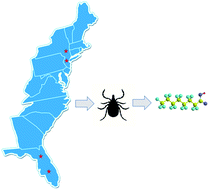Ticks as novel sentinels to monitor environmental levels of per- and polyfluoroalkyl substances (PFAS)†
Abstract
Per- and polyfluoroalkyl substances (PFAS) are environmentally persistent, ubiquitous pollutants. It is important to continuously monitor the presence of PFAS contamination, utilizing both legacy and new sentinels. In this study, environmental PFAS levels were evaluated using ticks as a sentinel model due to their world-wide distribution, hematophagous nature, and ease of collection and sampling. Hematophagy in discrete blood meals, from a suite of vertebrates, allows ticks to sample dozens of species of consumers and bioaccumulation across communities. Four different species of ticks, across two states (NY, n = 28 in mid-April of 2020 and FL, n = 32 between 2015 and 2020) with two sampling sites in each state were analyzed for the presence of 53 PFAS. The total PFAS concentration in ticks was the lowest at Newburgh (NY), a site that has been undergoing remediation efforts, while the highest total PFAS concentrations were measured in ticks at the Sweetwater site, a wastewater treatment wetland. Detection of PFAS and the potential for variation between tick species and between locations are necessary to establish the utility of ticks as sentinels, in addition to assessing additional environmental factors, such as other wildlife, water, or soil.

- This article is part of the themed collection: Urgent communications in RSC Environmental Science journals


 Please wait while we load your content...
Please wait while we load your content...